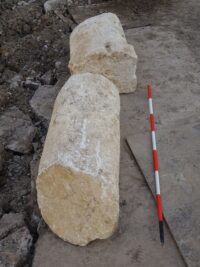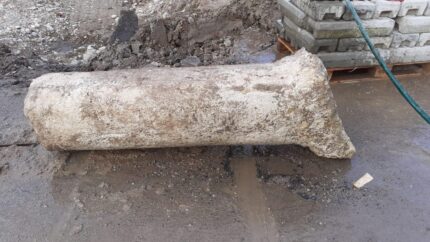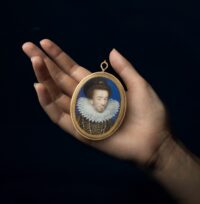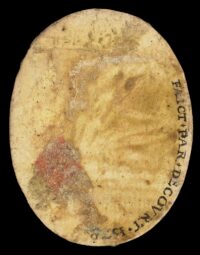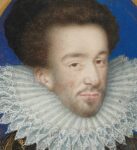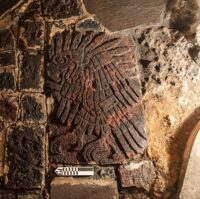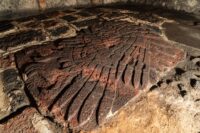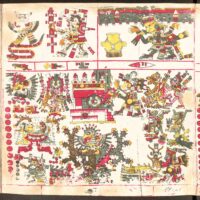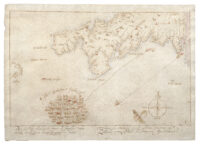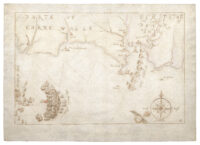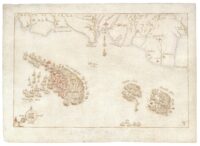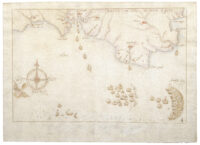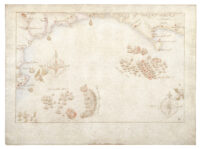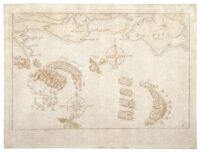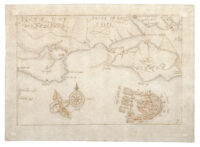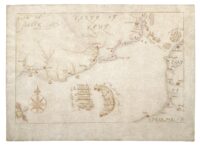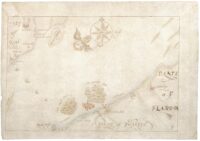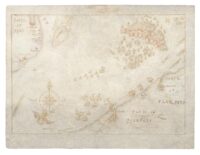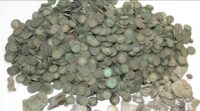 A large pot filled with 6,500 coins from the early 12th century has been discovered in a corn field in Słuszków, west-central Poland. Most of the coins identified so far are silver cross denarii. They were placed in linen sacks and hidden in a large earthenware vessel. Buried with the coins were fragments of lead and four gold rings — two granulated bands with polished cabochon stones and two wedding bands. One of the rings is a wedding ring engraved with a Cyrillic inscription reading “Lord, help your servant Maria.”
A large pot filled with 6,500 coins from the early 12th century has been discovered in a corn field in Słuszków, west-central Poland. Most of the coins identified so far are silver cross denarii. They were placed in linen sacks and hidden in a large earthenware vessel. Buried with the coins were fragments of lead and four gold rings — two granulated bands with polished cabochon stones and two wedding bands. One of the rings is a wedding ring engraved with a Cyrillic inscription reading “Lord, help your servant Maria.”
 The village of Słuszków is famous as the find site of Poland’s largest medieval coin hoard, discovered in 1935. That hoard of 12,500 silver cross pennies — the largest deposit of cross denarii ever discovered — and another 500 assorted silver coins and scraps was also buried in the early 12th century. The find was poorly documented at the time, and researchers went to the site in November 2020 to take some pictures and talk to the residents about the famous discovery.
The village of Słuszków is famous as the find site of Poland’s largest medieval coin hoard, discovered in 1935. That hoard of 12,500 silver cross pennies — the largest deposit of cross denarii ever discovered — and another 500 assorted silver coins and scraps was also buried in the early 12th century. The find was poorly documented at the time, and researchers went to the site in November 2020 to take some pictures and talk to the residents about the famous discovery.
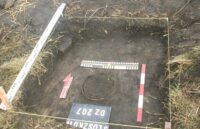 The find spot was not where the official story said it was in the northern part of town at the boundary of three properties. Dr. Adam Kędzierski of the Institute of Archaeology and Ethnology of the Polish Academy of Sciences spoke to a local priest who told him that he had heard back in the 1980s from the treasure hunters who discovered the first hoard that the find site was the field near the road. The team scanned the field with a metal detector and two days later, a small exploratory trench revealed the pot crammed with coins.
The find spot was not where the official story said it was in the northern part of town at the boundary of three properties. Dr. Adam Kędzierski of the Institute of Archaeology and Ethnology of the Polish Academy of Sciences spoke to a local priest who told him that he had heard back in the 1980s from the treasure hunters who discovered the first hoard that the find site was the field near the road. The team scanned the field with a metal detector and two days later, a small exploratory trench revealed the pot crammed with coins.
 Because of the high value of the hoard, the geographical proximity to even greater hoard and the rings, archaeologists suspect there may be an aristocratic connection. One possible candidate for the identity of Maria is the wife of Silesian prince Piotr Włostowic. Little is known about her beyond her name and that she was a daughter of Sviatopolk II, Grand Prince of Kiev and ruler of the Kievan Rus from 1093 to 1113. Maria’s older half-sister Zbyslava was married to Duke Bolesław III of Poland, and Piotr was Bolesław’s voivode, the country’s most powerful administrator and military leader.
Because of the high value of the hoard, the geographical proximity to even greater hoard and the rings, archaeologists suspect there may be an aristocratic connection. One possible candidate for the identity of Maria is the wife of Silesian prince Piotr Włostowic. Little is known about her beyond her name and that she was a daughter of Sviatopolk II, Grand Prince of Kiev and ruler of the Kievan Rus from 1093 to 1113. Maria’s older half-sister Zbyslava was married to Duke Bolesław III of Poland, and Piotr was Bolesław’s voivode, the country’s most powerful administrator and military leader.
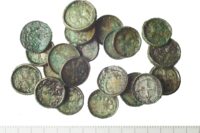 The professor who translated the inscription has posited a unified theory of Słuszków hoards almost as entertaining as it is speculative, hypothesizing that the hoards were Maria’s dowry, cached in 1146 when Piotr Włostowic found himself the target of one of the factions fighting over the succession after Bolesław’s death. Piotr was tortured, blinded and exiled, but far from cowed. He fled to the Kievan Rus and persuaded them to change allegiance to the faction that had not mutilated him. Next thing you know, Włostowic was back in Poland and voivode again until his death in 1153.
The professor who translated the inscription has posited a unified theory of Słuszków hoards almost as entertaining as it is speculative, hypothesizing that the hoards were Maria’s dowry, cached in 1146 when Piotr Włostowic found himself the target of one of the factions fighting over the succession after Bolesław’s death. Piotr was tortured, blinded and exiled, but far from cowed. He fled to the Kievan Rus and persuaded them to change allegiance to the faction that had not mutilated him. Next thing you know, Włostowic was back in Poland and voivode again until his death in 1153.


